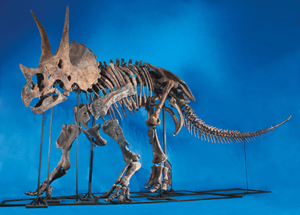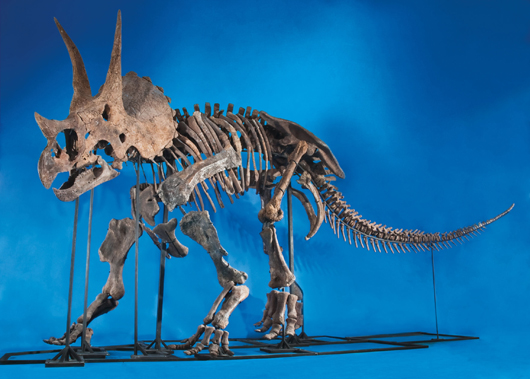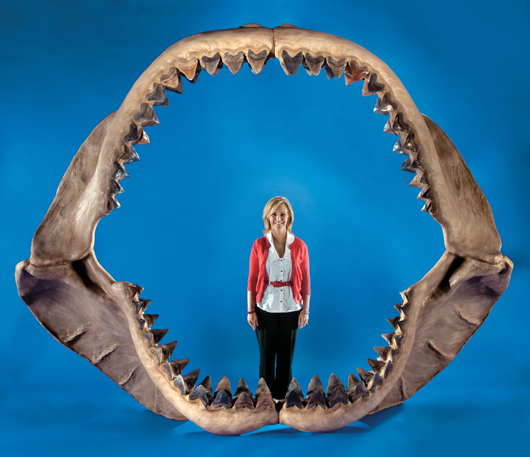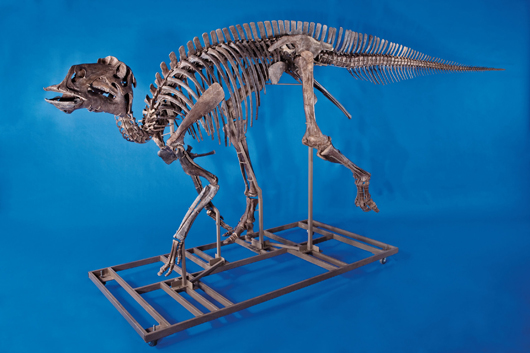
DALLAS – Visitors to Dallas’ Fair Park, where the Texas State Fair is held annually, will soon be taking a trip back in time – way back in time, to the days when dinosaurs roamed the earth. A display of no fewer than four complete or near-complete dinosaur skeletons is being prepared for its public unveiling at the fairgrounds’ 179-ft.-tall Tower Building.
Heritage Auctions is hosting the unprecedented exhibition, which includes “the fighting pair” – Allosaurus and Stegosaurus; a near-complete Triceratops, and a complete duck-billed Maiasaurus – along with dozens of important prehistoric treasures. All of the specimens are highlights from Heritage’s June 12, 2011 Natural History Auction and may be viewed in the Tower Building Thursday to Saturday, June 9-11, from 10 a.m. to 6 p.m., and Sunday, June 12, from 10 a.m. to 1 p.m.
“Every one of these incredible fossils is museum quality,” said David Herskowitz, director of Natural History at Heritage Auctions. “It’s rare to find even one truly great dinosaur for an auction, let alone the four we’ve managed to assemble for this summertime auction.”
Far and away, the stars of the dino show are the Allosaurus and Stegosaurus, known collectively as “the fighting pair” because of their proximity to one another when discovered in the Dana Quarry in Wyoming, in spring of 2007. The team of excavators at this legendary site thought they were on to the find of a lifetime when they found the Allosaur, whose name is Dracula. Imagine their surprise when they subsequently found a complete Stegosaur – named Fantasia – occupying the same space.
“They were literally right on top of one another,” said Herskowitz, “and they were evidently engaged in mortal combat at the time of their demise, as the leg of the Stegosaurus was found in the mouth of the Allosaurus. The association is undeniable.”
“The fighting pair” is being sold as a set due to its scientific importance. It carries a pre-auction estimate of $2.8 million.
Next in line is a virtually complete Triceratops skeleton, checking in at more than 19 feet long, seven feet across and more than 12 feet tall, found in the famous Hell Creek Formation in South Dakota in the spring of 2004. It is estimated at $700,000+, and will be on display at the Dallas Museum of Nature and Science, also at Fair Park in Dallas, through early June.
“The completed skeleton is enormous,” said Herskowitz. “If you can imagine this animal when it was alive bearing down on you with that massive skull and those epic horns, you wouldn’t stand a chance. This creature was the size of a small bus, and certainly a lot meaner.”
A complete duck-billed Maiasaurus, hailing from the Two Medicine Formation in northern Montana, completes the dinosaur quintet being sold in the auction. The specimen, named Cory, was originally discovered almost 20 years ago, but was not fully mounted until a few years ago. Measuring more than 17 feet (5 meters) in length, it is one of the most complete mounted specimens of this species known and possesses a particularly well-preserved skull. It is estimated at $450,000+.
While the dinosaurs will be center stage in the auction, it is the largest set of prehistoric shark jaws ever assembled, from the ferocious Megalodon, the largest predator that has ever existed, that may well steal the show from his terrestrial cousins. The jaws, when fully assembled, measure an impressive 11 feet across and almost 9 feet tall. It is estimated at $700,000+ and is also currently on display at the Dallas Museum of Nature and Science in Fair Park.
“The Megalodon was a shark that grew up to the length of two freight cars and preyed on whales and other sharks,” said Herskowitz. “This is the biggest Megalodon jaw ever assembled. It took 16 years to assemble and is composed of 182 fine-quality fossil teeth up to 7¼ inches in length. With jaws this size, and an appetite that was hugely voracious, you or I would be no more than an hors d’oeuvre for this monster.”
Most of the teeth in this specimen were personally collected in the rivers of South Carolina by the esteemed Vito Bertucci. The late Mr. Bertucci collected Megalodon teeth for more than 20 years, and his tireless work is on display in the American Museum of Natural History, the Houston Museum and the Baltimore Aquarium and has been featured in National Geographic World magazine and on the National Geographic Channel. He opened and operated a shark museum in Port Royal, S.C., before passing away in October of 2004 while diving for shark teeth.
Other prehistoric highlights of the auction include a superb Giant Ground Sloth skeleton, Late Pleistocene, 180,000 to 550,000 years old, estimated at $450,000+; a huge ferocious Dinosaur-Age Fish, dating to the Cretaceous period, estimated at $120,000+, and a giant Devonian Armored Fish skull more than 400 million years old, estimated at $40,000+.
Additional information is available by visiting Heritage Auctions online at www.ha.com.
# # #
ADDITIONAL IMAGES OF NOTE







